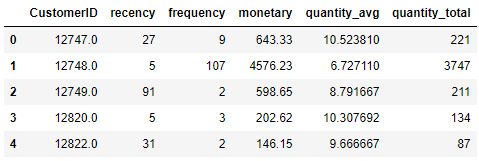Data preparation for purchase prediction
Machine Learning for Marketing in Python

Karolis Urbonas
Head of Analytics & Science, Amazon
Regression - predicting continuous variable
- Regression - type of supervised learning
- Target variable - continuous or count variable
- Simplest version - linear regression
- Count data (e.g. number of days active) sometimes better predicted by Poisson or Negative Binomial regression
Recency, frequency, monetary (RFM) features
- RFM - approach that underlies many feature engineering methods
- Recency - time since last customer transaction
- Frequency - number of purchases in the observed period
- Monetary value - total amount spent in the observed period
Explore the sales distribution by month
# Explore monthly distribution of observations
online.groupby(['InvoiceMonth']).size()
InvoiceMonth
2010-12 4893
2011-01 3580
2011-02 3648
2011-03 4764
2011-04 4148
2011-05 5018
2011-06 4669
2011-07 4610
2011-08 4744
2011-09 7189
2011-10 8808
2011-11 9513
dtype: int64
Separate feature data
# Exclude target variable online_X = online[online['InvoiceMonth']!='2011-11']# Define snapshot date NOW = dt.datetime(2011,11,1)# Build the features features = online_X.groupby('CustomerID').agg({ 'InvoiceDate': lambda x: (NOW - x.max()).days, 'InvoiceNo': pd.Series.nunique, 'TotalSum': np.sum, 'Quantity': ['mean', 'sum'] }).reset_index()features.columns = ['CustomerID', 'recency', 'frequency', 'monetary', 'quantity_avg', 'quantity_total']
Review features
print(features.head())
Calculate target variable
# Build pivot table with monthly transactions per customer
cust_month_tx = pd.pivot_table(data=online, index=['CustomerID'],
values='InvoiceNo',
columns=['InvoiceMonth'],
aggfunc=pd.Series.nunique, fill_value=0)
print(cust_month_tx.head())

Finalize data preparation and split to train/test
# Store identifier and target variable column names custid = ['CustomerID'] target = ['2011-11']# Extract target variable Y = cust_month_tx[target]# Extract feature column names cols = [col for col in features.columns if col not in custid]# Store features X = features[cols]
Split data to training and testing
# Randomly split 25% of the data to testing from sklearn.model_selection import train_test_split train_X, test_X, train_Y, test_Y = train_test_split(X, Y, test_size=0.25, random_state=99)# Print shapes of the datasets print(train_X.shape, train_Y.shape, test_X.shape, test_Y.shape)
(2529, 5) (2529, 1) (843, 5) (843, 1)
Let's work on data preparation exercises!
Machine Learning for Marketing in Python


